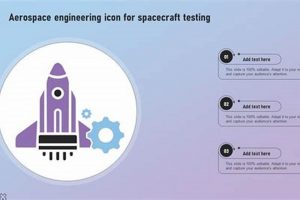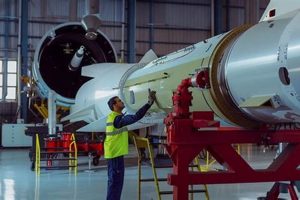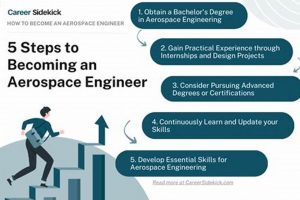The fundamental principles governing the design, development, and operation of vehicles that travel within and beyond Earth’s atmosphere constitute a core body of knowledge. This incorporates aspects of fluid dynamics, propulsion, structural mechanics, control systems, and materials science, all tailored to the unique challenges of flight. For example, understanding Bernoulli’s principle is crucial for designing airfoils that generate lift, a foundational element in aircraft design.
The mastery of these underlying ideas is essential for innovation and progress in aviation and space exploration. A thorough grounding enables the creation of more efficient, safer, and more capable aircraft and spacecraft. Historically, advancements in this field have driven technological progress across numerous sectors, from materials development to computer science, with significant societal and economic impact.
The following sections will delve into specific topics, illustrating the application of these core principles. This will include analysis of aerodynamic forces, propulsion systems, structural integrity, and the challenges of navigating and controlling vehicles in diverse environments.
Guidance on Fundamental Aerospace Principles
The efficient application of aerospace knowledge requires a solid foundation and a meticulous approach to problem-solving. The subsequent guidelines are designed to promote effective utilization of these key concepts.
Tip 1: Emphasize First Principles: Begin problem analysis by reverting to fundamental physical laws. For instance, conservation of energy and momentum are universally applicable and provide a robust starting point for analyzing complex systems.
Tip 2: Master Dimensional Analysis: Ensure all equations are dimensionally consistent. A failure in dimensional homogeneity indicates a fundamental error in the formulation of the problem.
Tip 3: Utilize Computational Tools Prudently: Employ software such as CFD or FEA to simulate complex phenomena, but always validate the results against experimental data or analytical solutions whenever feasible. Do not rely solely on computational results without critical evaluation.
Tip 4: Document Assumptions Rigorously: Clearly state all assumptions made during the modeling and analysis process. This transparency allows for a thorough assessment of the solution’s validity and limitations.
Tip 5: Prioritize Simplification: When appropriate, simplify complex systems using established techniques, such as linearization or quasi-steady state approximations. However, carefully consider the potential impact on accuracy.
Tip 6: Maintain a Systems-Level Perspective: Recognize that aerospace systems are highly integrated. Changes in one subsystem can have cascading effects throughout the entire vehicle. Consider the implications of design choices on overall system performance.
Tip 7: Embrace Iterative Design: Recognize that the design process is rarely linear. Expect to iterate through multiple design cycles, refining the solution based on analysis and testing.
Applying these guidelines promotes a more robust and reliable approach to aerospace problem-solving, leading to improved designs and a deeper understanding of complex systems.
This section highlights the importance of applying a structured and rigorous approach to the application of aerospace understanding. The following sections will expand on the practical implications of these methodologies.
1. Aerodynamics
Aerodynamics, as a cornerstone discipline, exerts a profound influence across the entirety of aerospace engineering. It is the study of how air interacts with moving objects, shaping the design, performance, and limitations of aircraft, spacecraft, and related systems. The principles of airflow, pressure distribution, and boundary layer behavior directly dictate the lift, drag, and stability characteristics of a vehicle. For example, the Wright brothers’ meticulous experimentation with airfoil shapes was crucial to achieving controlled, sustained flight; their understanding of aerodynamics directly translated into a functional aircraft.
Consider the design of a supersonic aircraft. The aerodynamic considerations are paramount, requiring careful management of shockwaves and minimizing wave drag. Computational Fluid Dynamics (CFD) is employed to simulate airflow around the aircraft, optimizing its shape for minimal drag at high speeds. Similarly, in spacecraft design, understanding the effects of rarefied gas dynamics is essential during atmospheric entry and orbital maneuvers. The Space Shuttle, for instance, relied on precisely engineered aerodynamic surfaces for controlled descent and landing, showcasing the critical role of aerodynamics in ensuring mission success.
In summary, aerodynamics is not merely a theoretical discipline but an indispensable foundation for all aspects of aerospace design and operation. Its understanding is crucial for optimizing performance, ensuring stability, and mitigating risks across a broad spectrum of aerospace applications. Challenges remain in accurately predicting complex flow phenomena, particularly in turbulent regimes, highlighting the ongoing need for advancements in both theoretical modeling and experimental validation to push the boundaries of aerospace technology.
2. Propulsion
Propulsion represents a critical and enabling element within the broad spectrum of aerospace systems. Without effective propulsion, sustained atmospheric flight and extraterrestrial exploration would remain unattainable. Propulsion systems directly govern a vehicle’s ability to overcome gravity and atmospheric drag, achieve desired speeds and altitudes, and execute complex maneuvers. The interplay between thrust generation, fuel efficiency, and system weight dictates overall vehicle performance and operational range. Rocket engines, for example, enable spacecraft to escape Earth’s gravity and navigate interplanetary space, while jet engines provide sustained thrust for long-duration air travel.
The type of propulsion system employed fundamentally shapes the design and operational characteristics of an aerospace vehicle. For instance, a satellite utilizing ion propulsion, with its low thrust but high specific impulse, can execute precise orbital corrections over extended periods. Conversely, a fighter aircraft relies on turbojet or turbofan engines to provide high thrust-to-weight ratios for rapid acceleration and maneuverability. Hybrid systems, combining different propulsion principles, represent a frontier in aerospace innovation, offering potential advantages in both efficiency and performance. The development of reusable launch vehicles, driven by the need to reduce space access costs, critically depends on advancements in propulsion technologies, enabling controlled landings and rapid re-flights.
In conclusion, propulsion is inextricably linked to the capabilities and limitations of any aerospace vehicle. Understanding the principles of propulsion, from thermodynamic cycles to combustion processes, is paramount for engineers involved in aerospace design and operation. Continuous advancements in propulsion technologies, driven by the pursuit of higher performance and greater efficiency, remain central to expanding the boundaries of air and space travel. The practical significance of this understanding is evident in the continuous development and refinement of propulsion systems across various sectors, including commercial aviation, military applications, and space exploration.
3. Structures
The structural integrity of any aerospace vehicle is paramount to its successful and safe operation. Structures, in the context of aerospace engineering, refer to the framework that provides the necessary shape, stiffness, and strength to withstand the various loads encountered during flight or space travel. The design and analysis of these structures are deeply intertwined with core principles of materials science, mechanics, and aerodynamics. The ability to predict and manage stress distributions, fatigue, and buckling phenomena is crucial for preventing catastrophic failures. For example, the Comet airliner disasters of the 1950s highlighted the critical importance of understanding fatigue in pressurized fuselages, leading to significant advancements in structural design and non-destructive testing techniques.
The selection of appropriate materials and construction methods is a key aspect of aerospace structural design. Lightweight materials, such as aluminum alloys, titanium alloys, and composite materials, are commonly employed to minimize weight while maintaining structural integrity. Finite element analysis (FEA) is routinely used to simulate the behavior of complex structures under various loading conditions, enabling engineers to optimize designs and identify potential weaknesses. The structure of a satellite, for instance, must withstand the stresses of launch, the thermal cycling of space, and the potential impact of micrometeoroids. Similarly, aircraft wings must be designed to withstand aerodynamic loads, gust loads, and maneuver loads throughout the flight envelope.
In summary, the field of aerospace structures is fundamental to ensuring the safety and reliability of aircraft and spacecraft. A thorough understanding of structural principles, materials behavior, and analytical techniques is essential for aerospace engineers. Ongoing research and development efforts are focused on improving structural performance, reducing weight, and enhancing durability in increasingly demanding operating environments. The practical application of this knowledge directly impacts the performance, safety, and lifespan of aerospace vehicles.
4. Control Systems
Control systems constitute an indispensable element within the framework of concepts governing aerospace engineering. They provide the mechanisms for maintaining stability, executing maneuvers, and autonomously navigating aircraft, spacecraft, and related vehicles. The absence of effective control systems renders flight unstable and space missions impossible, highlighting their critical role in realizing the operational objectives of aerospace systems.
- Stability Augmentation Systems (SAS)
These systems enhance the inherent stability of an aircraft, particularly in configurations that are naturally unstable or require precise control in turbulent conditions. By employing sensors to detect deviations from the desired flight path, SAS automatically adjusts control surfaces to counteract disturbances, improving handling characteristics and reducing pilot workload. For example, fly-by-wire systems in modern fighter aircraft rely heavily on SAS to enable precise control at high speeds and during complex maneuvers.
- Navigation and Guidance Systems
These systems determine the position, velocity, and attitude of a vehicle and guide it along a pre-defined trajectory or towards a specific target. Inertial navigation systems (INS), coupled with GPS or other external references, provide autonomous navigation capabilities for aircraft and spacecraft, enabling them to operate in environments where external guidance signals may be unavailable. The guidance systems used in intercontinental ballistic missiles (ICBMs) exemplify the precision and reliability required in these applications.
- Flight Control Surfaces and Actuation
This encompasses the physical components that directly manipulate the airflow around an aircraft or spacecraft, such as ailerons, elevators, rudders, and flaps. Actuation systems, typically hydraulic, electric, or pneumatic, provide the force necessary to move these surfaces in response to pilot inputs or automated control commands. The design and placement of control surfaces, along with the characteristics of the actuation system, significantly influence the vehicle’s maneuverability and responsiveness.
- Attitude Control Systems (ACS)
These systems are crucial for spacecraft, enabling them to maintain a desired orientation in space. ACS utilize thrusters, reaction wheels, or magnetic torquers to control the spacecraft’s attitude and point its sensors or antennas towards specific targets. Precise attitude control is essential for Earth observation satellites, communication satellites, and interplanetary probes, ensuring that they can effectively perform their intended functions.
The facets of control systems discussed above are integral to the practical application of aerospace engineering concepts. Effective control systems are the linchpin for performance and reliability for both atmospheric and space applications. Continuous advances in sensor technology, control algorithms, and actuation systems continue to push the boundaries of what is achievable. The examples provided demonstrate the practical significance of control systems, underscoring their pervasive influence in modern aerospace technology.
5. Materials
The selection and application of materials are inextricable from the foundational understanding of aerospace engineering. The properties of these substances directly influence the performance, safety, and longevity of flight vehicles. Consider, for example, the impact of material density on aircraft weight. A reduction in density, achieved through the use of aluminum alloys or composite materials, translates directly into increased fuel efficiency, extended range, and enhanced payload capacity. Simultaneously, these materials must exhibit sufficient strength and stiffness to withstand the stresses encountered during flight, including aerodynamic loads, thermal stresses, and vibrations. Failures in material integrity can lead to catastrophic consequences, underscoring the critical importance of thorough materials characterization and rigorous testing procedures.
The operational environment further dictates material selection criteria. Spacecraft operating in low Earth orbit are subjected to extreme temperature variations, vacuum conditions, and radiation exposure, necessitating the use of materials with high thermal stability, low outgassing rates, and radiation resistance. The development of ablative heat shields for atmospheric re-entry provides a tangible example of materials engineering in action. These specialized materials are designed to sacrifice themselves, dissipating heat through sublimation and preventing the vehicle from overheating. The practical application of these concepts ensures the survival of spacecraft during the perilous re-entry phase. Turbine blades in jet engines, another instance, operate at extremely high temperatures and are subject to significant centrifugal stresses. The use of nickel-based superalloys with sophisticated cooling techniques allows these blades to withstand these extreme conditions, enabling efficient and reliable engine operation. In both cases, materials science enables the achievement of specific aerospace goals.
In summary, materials science stands as a critical cornerstone within the broader landscape of aerospace engineering. The ability to select, characterize, and apply materials appropriately is paramount to designing safe, efficient, and durable aircraft and spacecraft. Continuous research and development efforts focused on new materials and advanced manufacturing techniques promise to further enhance the capabilities of aerospace systems, enabling exploration of space and advancements in air travel. A thorough understanding of materials properties and their interactions with the operational environment remains essential for all aerospace engineers.
6. Orbital Mechanics
Orbital mechanics is a core discipline within aerospace engineering, providing the framework for understanding and predicting the motion of artificial satellites and other celestial bodies. Its principles are crucial for mission planning, spacecraft design, and ensuring the successful operation of space-based assets.
- Keplerian Elements and Orbit Determination
Keplerian elements (semi-major axis, eccentricity, inclination, longitude of ascending node, argument of periapsis, and true anomaly) provide a standardized method for defining and characterizing orbits. Determining these elements from observational data is fundamental for tracking satellites, predicting future positions, and planning orbital maneuvers. For instance, accurately determining the orbit of a communications satellite is essential for maintaining reliable signal coverage. The implementation of Keplerian elements forms a cornerstone of orbital mechanics applications.
- Orbital Maneuvers and Delta-V
Orbital maneuvers involve altering a spacecraft’s orbit using propulsive burns. The required change in velocity, known as delta-V, is a critical parameter in mission planning, directly influencing fuel consumption and mission duration. Hohmann transfers, bi-elliptic transfers, and plane changes are common types of orbital maneuvers. For example, a geostationary transfer orbit (GTO) requires a specific delta-V to circularize the orbit at geostationary altitude. Delta-V calculations are essential for all propulsive orbital corrections.
- Perturbations and Orbit Maintenance
Real-world orbits deviate from ideal Keplerian orbits due to various perturbations, including gravitational forces from the Sun, Moon, and other planets, atmospheric drag, and solar radiation pressure. These perturbations cause orbital parameters to change over time, necessitating orbit maintenance maneuvers to keep satellites within their designated orbital slots. Accurate modeling of these perturbations is crucial for long-duration missions and precision orbit determination. Space debris tracking depends on accounting for these subtle yet significant influences. This is essential for collision avoidance in operational space missions.
- Interplanetary Trajectory Design
Interplanetary missions require sophisticated trajectory design to minimize fuel consumption and travel time. Gravity assists, where a spacecraft uses the gravitational field of a planet to alter its trajectory and velocity, are a common technique. The Voyager missions, for example, used multiple gravity assists to explore the outer solar system. Interplanetary trajectory calculations involve complex optimization algorithms and a deep understanding of celestial mechanics. These algorithms are critical for manned and unmanned deep space exploration programs.
The concepts of orbital mechanics underpin numerous applications within aerospace engineering, from satellite communications and Earth observation to space exploration and national security. A thorough grasp of these principles is essential for engineers involved in the design, analysis, and operation of space-based systems. The examples provided underscore the practical significance of orbital mechanics in enabling a wide range of space activities.
Frequently Asked Questions on Foundational Principles
This section addresses common inquiries regarding the principles underpinning aerospace engineering. The responses aim to provide clarity and enhance understanding of this complex field.
Question 1: What are the primary disciplines that constitute the basis of understanding for Aerospace Engineering?
Core domains include aerodynamics, propulsion, structures, control systems, materials science, and orbital mechanics. Proficiency in these areas is essential for designing and operating aerospace vehicles.
Question 2: Why is aerodynamics of such importance in aerospace engineering?
Aerodynamics governs the interaction of air with moving objects, impacting lift, drag, stability, and control. The design of airfoils, wings, and entire aircraft relies heavily on aerodynamic principles to optimize performance and safety.
Question 3: In aerospace engineering, what considerations drive propulsion system selection?
Factors such as thrust requirements, fuel efficiency, weight limitations, and operating environment influence propulsion system selection. Different vehicle types require different engines, from rocket engines for spacecraft to turbojets for high-speed aircraft.
Question 4: Why is structural integrity so crucial for aerospace vehicles?
Structural integrity ensures the ability of an aerospace vehicle to withstand aerodynamic loads, vibrations, and thermal stresses without failure. Lightweight materials and robust structural designs are vital to achieving this while minimizing weight.
Question 5: How do control systems contribute to the operation of aerospace vehicles?
Control systems maintain stability, execute maneuvers, and enable autonomous navigation. These systems utilize sensors, actuators, and control algorithms to adjust control surfaces and manage vehicle attitude.
Question 6: What role does orbital mechanics play in aerospace engineering?
Orbital mechanics provides the framework for predicting and controlling the motion of spacecraft. Understanding orbital parameters, maneuvers, and perturbations is essential for mission planning and satellite operations.
The preceding answers aim to clarify key aspects regarding the fundamental principles of aerospace engineering. A comprehensive understanding of these concepts is crucial for success in this field.
The subsequent section will explore further areas of interest within the realm of aerospace engineering.
Conclusion
The preceding discussion has elucidated the core tenets that define concepts of aerospace engineering. From the foundational role of aerodynamics and propulsion to the critical importance of structural integrity, control systems, and materials science, these interlinked disciplines form the bedrock upon which flight and space exploration are built. Furthermore, the application of orbital mechanics is indispensable for enabling satellite operations and interplanetary missions. Proficiency in these principles is paramount for engineers striving to innovate and advance the field.
As technology continues to evolve, the mastery of these fundamental concepts remains essential for tackling the complex challenges that lie ahead. Continued research and development efforts are crucial for achieving higher performance, greater efficiency, and enhanced safety in aerospace systems. A commitment to rigorous analysis, innovative design, and a deep understanding of the underlying physics will drive future progress and shape the next generation of aerospace capabilities.







